Latvia: Year of Horror, 1940 – The Year Assimilated Jews Turned on Their Neighbours
Warning!
The following contains disturbing imagery
Parental guidance is highly recommended
Latvia: Year of Horror. is an highly illustrated,
chronological eyewitness and documented account of the suffering the Latvian people endured at the hands of the Jewish-Bolshevik
invaders and, the assimilated Latvian-Jews, who, in the summer of 1940, began a slaughterous oppression with the
arrival of the Jewish Red Army.
It all started on the 15th of June 1940, at 2:30am, when the NKVD raided a Latvian Boarder
Post, then with the Red Army invasion of the Latvian Territory and occupation of Riga, on the 17th of June, 1940. Latvia’s
terror started at once with the mass arrests, murders and/or deportations of its leaders to far regents of Bolshevik Russia,
as revolutionary criminals were released from Latvian prisons, to assist the Red Army and replace the slain and deported
in their positions. It followed later with thousands of Latvians being arrested without warrant, loaded onto railway freight
carriages and deported to the far east to join their leaders in frost-bitten death camps, or they were just outright murdered
in their homeland. This left the blood-soaked nation leaderless, until the onset of the preemptive German mobilisation of Operation Barbarossa against the Soviet aggression toward the west, who arrived in Latvia on Sunday
June 22, 1941 and, finally arrived at Riga on July 1, 1941. They were welcomed as Liberators by the Latvian people, who then
turned their suffering into revenge against many of the Jewish occupiers… but they are now referred to as ‘Pro-Nazi
Sympathisers and Collaborators’ by the victors.
The highly illustrated booklet, ‘Latvia: Year of Horror‘ is reproduced below with only formatting, spelling and minimal translation amendments for comprehension purposes,
but has been kept as close as possible to the original 1942 translation and accuracy of detailed facts. The relevant video
footage contained is an additional inclusion by Historical Tribune.
Latvia: Year of Horror
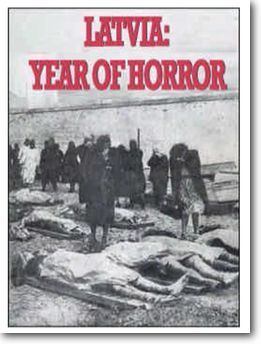
Edited by Paula Kovalevskis,
Oskars Noritis and Mikelis Goppers. Published by Zelta Abele, 1942.
Latvia: Year of Horror, is a collection of photos and documents covering the communist rule in Latvia from June 17, 1940 to July 1, 1941.
This book shows communism as it was in reality — cloaked in deception and lies, filled with inhuman cruelties, reveling
in torture and blood, sadistic in its delight in the lamentations of sufferers, and infinite in revenge and destruction.
An unfathomable darkness, a madness, a mockery of honour and a rejection of all virtue sought to annihilate nothing less
than the soul of the Latvian nation, a people for more than 4,000 years.
“Latvia: Year of Horror, an historical, unexpurgated publication,
not adhering to any political fashion or line, has the blessing of God. These are the plain facts. There are no grounds
to consider it anti-Semitic literature.” Reverend Karlis Zuika
Forward
The reprinting
of Baigais Gads (Latvia: Year of Horror) is not only laudable and welcome, it is also necessary. This book deals
with a turning point in Latvian history, which must not remain hidden.
Latvia: Year of Horror, was the first (1942) and, at this moment, the only full documentation of
the horrible events of 1940. It offers a precise witness account of that time in Latvian history.
It is an historical documentation of the now, all-but-forgotten events in Latvia of that horrible summer
of 1940. It is a period of time filled with tragedy. A manipulation of historical events to suit today’s needs is
not allowable… These are the facts!
To read the later adapted Introduction to Latvia:
Year of Horror, see here, pages 3 – 5.
The Beginning
On June 15/16, 1940, many Latvians had gathered to attend the song
festival in Daugavpils. This was to be the last such festival for free Latvians for almost half a century. The attack by
Stalin’s communists on the night of June 14, 1940 was the prelude to Latvia’s road of suffering. The orgy of
bloodshed had begun. On this night, the “great Eastern neighbour” — the Soviet Union — after a silence
of 23 years, took the first step in the dance of death on Latvian soil. Their invasion was their calling card and showed
how the Bolsheviks betrayed their commitments undertaken in the Mutual Assistance Pact of 1939.

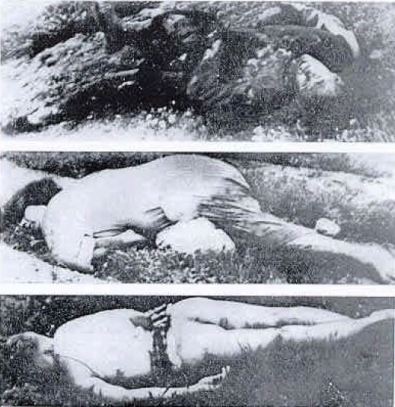
- They
burned the quarters of Latvian border guards in the Maslenkis community in Augspils Township (above)
- The half-burned body of border guard Macitis (top right).
- The body of Hermine, wife of border guard Purins (middle right).
- The body of border guard Beizaks. (bottom Right).
The son of border guard Purins died in hospital from fatal
injuries. Border guard Cimosko died with Beizaks. Forty-three border guards and nearby residents who tried to save the burning
quarters were seized by the invading communists and taken across the border as prisoners.
These events
took place at the very time that the Bolshevik press proclaimed: “The Soviet Union has maintained and continues
to maintain a policy that is beneficial and to the highest degree pro-Latvian.”

The arrival of the Bolsheviks
in Riga, the Latvian capital, via the Iron Bridge.
View from the central market on
the afternoon of June 17th, 1940.
The cynicism and bestiality shown by Soviet
rule seemed unbelievable. The hypocrisy and falsification of truth were incomprehensible. Yet, they did happen. The official
announcements by the Latvian Government protesting the invasion, had no effect. Moscow proceeded according to plan for the
invasion and annexation of Latvia. These plans were thorough and far-reaching.
On the morning of June 17th, Latvia was overrun
by the armed hordes of Communist Russia. Many of the invading troops were Asiatic units who could, thus, not speak to the
victims.
Communist-instigated mob, incited disorder at
Riga’s Police Headquarters

The Main Post Office in
Riga on the day of the communist invasion.
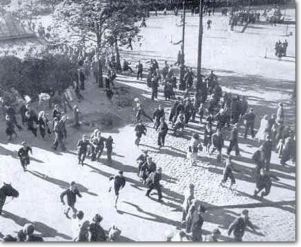
Attacks on the Latvian
Police, on the Soldiers and Officers of the Latvian Army took place in the Capital and throughout the Country. Rocks were
thrown at the Police by the Communist-instigated mob.
…But from the underground, sensing ideological
allies in the Bolsheviks, there arose “the oppressed masses” groups of hooligans, criminals, vagabonds,
many Jews, “the Chosen People”, to welcome the invaders and to attack the police as they tried to maintain
order in the streets packed with the invading Soviet soldiers.
The Red Army
arrived “to assure the realisation of the USSR and Latvia’s mutual assistance pact,” who embraced
and protected the pro-communist rioters. Thus, the Soviets demonstrated who deserved their “mutual assistance”
and it was not the Latvian nation at large.
Grimly silent, Latvians on the
sidewalks were watching a real life drama, about which no one at the time could sense the horrific outcome of the final
act.

After the dispersal of the mob, the area of the railroad station and around police headquarters was
littered with rocks hurled by the communist rioters.
 The Latvian institutions, not yet familiar with the practices of the Bolshevik invaders, attempted to enforce the laws of
the land, in the belief that those who had incited the riot should be charged and punished. This was a bitter delusion.
The Soviet Embassy explained that it was satisfied with the manner in which the Red Army’s arrival in Riga had been
welcomed! The names of the hooligans charged for rioting indicate their mostly Jewish origin; Genech Kreiness, David Goldberg,
Heim Klackin, Grigory Varuskin, Abramy Gemjanov, etc.
The Latvian institutions, not yet familiar with the practices of the Bolshevik invaders, attempted to enforce the laws of
the land, in the belief that those who had incited the riot should be charged and punished. This was a bitter delusion.
The Soviet Embassy explained that it was satisfied with the manner in which the Red Army’s arrival in Riga had been
welcomed! The names of the hooligans charged for rioting indicate their mostly Jewish origin; Genech Kreiness, David Goldberg,
Heim Klackin, Grigory Varuskin, Abramy Gemjanov, etc.
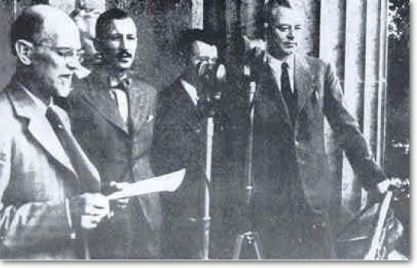
All these events were legitimised. A new government
took power on orders from Moscow. The duly constituted Latvian Government was replaced. At left: Puppet President, Professor
Kirchensteins addresses the crowd, with Peter Blaus and Julius Lacis. Demonstrators requested and got the legalisation of
the Latvian Communist Party.
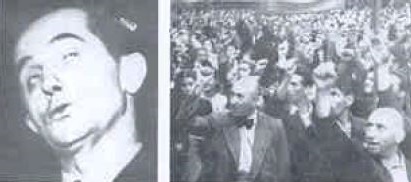
The sensitive ear of the Latvian Communist Party’s first Secretary, Kalnberzins-Zakis, who carefully noted the
“just demands of the nation“, in reality, his orders were from Moscow.
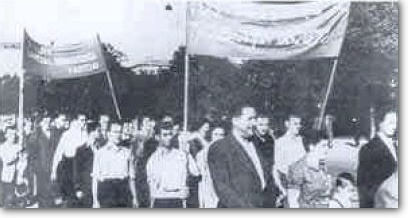
What Nationality were they? The language and
characters on the signs indicate, clearly – Jews!
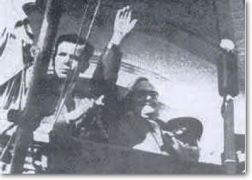
The master of Ceremonies of all events planned by Moscow, the Chairman of the
Supreme Soviet, of the Soviet Union, Comrade Vishinski (at left), greeted the “friendly” demonstrators and stated
his belief that, in the future, the Soviet and Latvian flags would fly side by side. The future would reveal this to be
a barefaced lie and would expose the cynical intentions behind this statement.
On June 21st, workers were forcibly driven out into the streets to participate in a “demonstration of joy” to hail,
with many enthusiastic Jews, their own future murderers. The Soviet power, already having taken under its wing the crowd
of hooligans, now released prisoners guilty of illegal political activities. Sadly, it did not occur to the new puppet government
that the USSR would establish its “pro-Latvian policy” with the aid of Enemies
of the State! This coerced demonstration in Riga, was a forerunner of future manufactured “support”
for the planned implementation of Soviet power.

Mostly Jewish
crowd awaits the release of political prisoners from Central Prison in Riga.

Newly released
criminals parade out of prison.

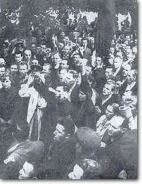
Prisoners, accompanied by largely Jewish crowd and the coerced crowd of demonstrators, enter the
street. A Prisoner addresses the crowd. His face clearly contorted with hate and a desire to destroy.
The prisoners and crowd of Jews were of one mind: the Soviets in power were their real friends.
The Soviet Embassy on Anthony Street, was the den where the local hirelings fulfilled Moscow’s plans. The masses had
no notion of their contents. Many even opined – as did many gullible people in the West – that, in its 23 years
of existence, communism had changed for the better.
The largely Jewish
crowd cheered the speaker addressing the crowd. Their “roaring cheers for the liberators” became understandable
only later.
[left] Deported or escaped anti-government Bolsheviks returned from Sweden. It is not necessary to note that most
of them were Jews. [centre] The former Spanish Civil War Red Front volunteers, are greeted by Jewish functionaries. [right]
Simultaneously, Red Army soldiers staged performances in the city’s parks and gardens, displaying their “culture”
and diverting attention from the destruction planned for the Latvian nation. Everything proceeded according to plan.
All interested
in the destruction of the state of Latvia, of the Latvian nation and the ruin of its values, had now met and joined arms.
The team of destroyers were now in place.
With forces unified, the destruction of the existing system, order and values
could begin. A fearless hand stabbed in the back, the nation’s greatest and best organised guard and support: the Latvian
Army was to be Bolshevised! This task was entrusted to largely Jewish hands.

Pictured left and below on the left, is one of the new power brokers, Abraham
Genkins, a Jew. He had been a soldier in the Latvian Army in the Courland Division, Labour – that is, a punishment
or military prisoner – Commando in Liepaja. He had been arrested for subversive activities. With the arrival of the
Bolsheviks, this criminal was promoted to the rank of “Politruk” (Political Commissar) in the Artillery Division.
He is seen wearing the uniform of a Latvian Army officer (below left).
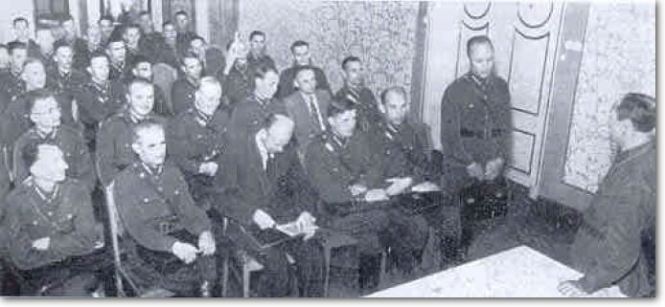

Into the Latvian Army, “Politruks”
– Political Commissars – with no military training and often without even grade school education – were
introduced. Frequently, they had criminal pasts and were promoted at once, to the ranks of Captain or Colonel. The first
and essential condition of their appointment was that the army must not be a-political. [image right] “Political Indoctrination”
session during training in one Latvian Army unit. On the left, a “Politruk.”
The work of destruction continued feverishly.
It was necessary to falsify the wishes of the nation in order to ratonalise actions, to which no one with common sense would
agree. On July 15/16, in elections for the Saeima, the Parliament, the people were compelled to vote for only one existing slate and were forcibly driven to the polls. Afterwards, holders of passports that did not
have a stamp indicating they had participated in the voting, were considered to be traitors! Propaganda signs in Russian
and such coercive methods, left no doubt about the purpose, persistence and relentlessness of Bolshevik intentions.
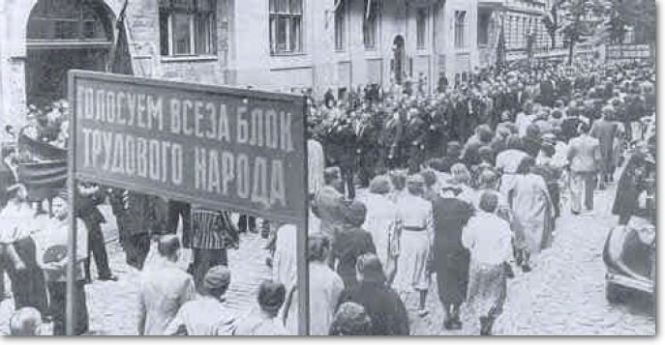
One of the forced
marches from work to voting stations where there was only one choice on the ballot.

The fateful “newly
elected” session of the Saeima opened on July 21, 1940. There, the destiny of Latvia was to be decided and the Latvian
Soviet Socialist Republic (SSR) was founded.
To Moscow!
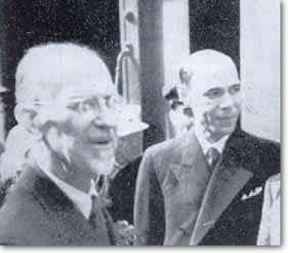
Professor Kirchensteins
and the Soviet Ambassador at the Riga railroad station, leaving for Moscow.
Official
statistics show that, in spite of coercion of the voting process, a significant number of voters abstained. Therefore, the
new Soviet rulers announced that participation in the election had been nearly 100% of the electorate. The new members of
the Saeina, elected as they were in forced and staged elections, now took the next step of high treason and resolved to approve
the annexation of Latvia to the Soviet Union.
Professor Kirchensteins, the new President-in-waiting, undertook the task of begging Moscow
for mercy to realize this goal. This was done. All obstacles to Bolshevik plans had been removed.

The real meaning of these events was best expressed in the rejoicing of so many Jews. For the Latvian nation, the
hardest moments of awareness and a crucial test of its very existence, had arrived.
In Moscow, the long planned sequence of events
reached its conclusion. The Latvian nation had been dragged to a threshold, the crossing of which was designed to erase it
from the registry of nations forever!

It was no secret what the result of Professor Kirchensteins’ trip would
be. This was to be the last act in a masterfully directed drama. It was to prove to the world that the Latvian nation “ardently
wishes to join the family of other nations in the Soviet Union.”
The request to incorporate Latvia into the Soviet Union was in the
hands of the press on the day of Kirchenstein’s arrival in Moscow. However, Moscow already knew what it wanted and
what was to be done.
Everything proceeded as planned. On August 5th, 1940, the fate of Latvia was sealed.
Most Jews
were ecstatic. The demonstrations on August 5th, turned into Jewish National celebrations.

With the Communist
Revolutionary fist salute, Jews request the annexation of the State of Latvia to the Soviet Union.
The State of Latvia
Ceases to Exist on August 5th
Like a mockery of truth, the Soviet newspaper, Izvestia, reported on August 6th: “Yesterday,
the U.S.S.R. Supreme Soviet separately voting by chambers unanimously agreed to accept the request of Latvia’s Saeima
to include the Latvian SSR (Soviet Socialist Republic) into the U.S.S.R.’s fraternal family of nations.”

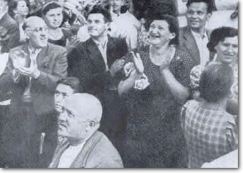
The Jews rejoiced
most.
The following day, large numbers of Jews in Latvia again rejoiced,
and their joy was unrestrained. However, Latvians driven into the streets to join in “gratitude” demonstrations
were grim-faced. As of this moment, they had lost their free will and their destiny was completely in Moscow’s hands.
There was only one road left open to the Latvian nation – to close ranks and with heads proudly raised, inspired by
love and loyalty for the land of their fathers, to resist and meet the fate of martyrs.
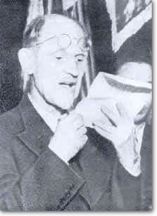
Acting President
and Prime Minister, Prof. Kirchensteins
This man, Professor Kirchensteins, to make believable
the grossly falsified will of the Latvian people, hypocritically lied:
“The workers of Latvia suffered from unemployment and lived
in hunger… Every attempt to gain human subsistence and rights and to determine their own future, they paid for with
suffering and torment, with incarceration of their best sons and daughters in prison and forced labour camps… Only
the inclusion into the U.S.S.R. assures real independence, development of industry, agriculture, the blossoming of real
national culture, brilliant and powerful rise of material and cultural well being…”
[As George Orwell would write in his novel, 1984,
the Communist world peace is war and freedom is slavery.]
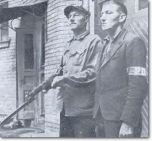
The new communist power was established. Loyal guards
and support had to be provided. Already operational was the Institute of Police Assistance Service “P.D.” With
few exceptions, this was comprised of the dregs of society: thieves, burglars, cheats. This institution eventually became
the People’s Militia. Many Jews and hardened criminals were entrusted with the organisation and supervision of these
institutions.
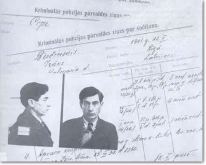
Organiser of the
Workers’ Guard & People’s Militia, a man with a long criminal record; a Jew, Izak Bucinskis
The duties of the police were assumed by the newly founded People’s Militia, although
their primary task was not to fight crime. This concept lost its meaning when criminals were released from prisons and the
leadership of security establishments were handed over to them. The militiamen had mastered shooting, in the event they
had to face their own countrymen. Hardly able to read or write, they controlled identity documents in search of enemies of
the new regime. These were considered to be anyone decently attired or intelligent looking.
Workers received arms and founded Workers’ Guards. Among them were women, there on the understanding
they would not flinch when executing their duties.
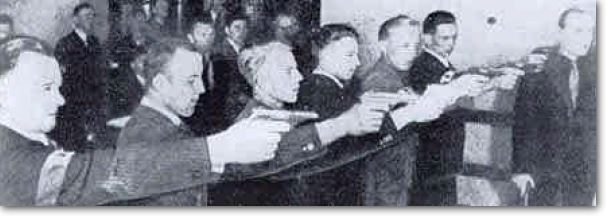
People’s
Militia at Target Practice 
Militiamen
check identity papers of pedestrians in Riga. [centre] The Workers’ Guard in formation in honour of the delegation
from Moscow. The women of the Workers’ Guard. To allay suspicions, many workers joined the Guard, even
though they had no connections with the Bolsheviks. To justify the existence of this armed guard, the Bolsheviks invented
horror stories about sabotage. The guards were guarding the factories against imaginary ghosts.
Bolshevik Cynicism

In those few weeks was hidden the most horrible villainy of Bolshevik cynicism. From the very
first days of the occupation rule, word spread like wildfire of the first wave of arrests. The prisons, emptied of recidivists,
criminals, Bolshevik agents, subversives, spies and illegals, quickly filled with Latvian patriots. Former Latvian policemen
were arrested for attempts to maintain order during the largely Jewish-incited riots in city streets. Every other Latvian
who wore a uniform was arrested – soldiers, border guards, home guards – or those who were in a supervisory
position in the former government offices, as well as judges who ruled in accordance with the prevailing law, and finally,
those who openly and proudly announced their affiliation to the Latvian nation. Ironically, at the same time, the Bolsheviks
proclaimed the equality and brotherhood of nations.
Unrest and agitation among the people grew. The nation, confused
and shaken by events arranged by cynical and coldblooded minds, was facing an uncertain future and sensed the presence of
danger. The occupation power was fighting the distrust and hatred of the nation. There would be no reprisals, the puppet
regime promised! That had to be repeated again and again, not because this power attempted to establish and secure authority
and regain the lost trust, but rather it exploited the existing and freshly and deliberately provoked antagonisms to arrive
at its real goal: To Destroy “Harmful elements“. These elements were the whole independence-minded Latvian
nation.
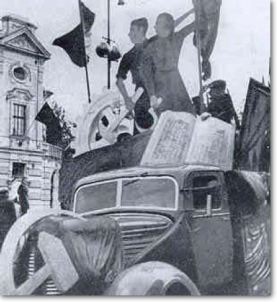
Streets were crowded
with a variety of signs and displays on which much money was spent.
“There shall be no reprisals.”
These words encompass the oldest Bolshevik lie, their most horrible deeds perpetrated during the year of their rule. Words
seemingly expressing trust and forgiveness hid the real intent of the Bolsheviks – the destruction of the Latvian
nation.
When a year later, the ground opened up and the corpses disclosed
the truth, it was more horrible than anything anyone had imagined or feared.
On the 26th International Bolshevik Youth Day, Latvians were again coerced. Students were ordered out into the streets.
The Bolsheviks had to prove to the world that the nation and especially the youth understood and loved the new era and that
they “freely and without coercion rejoiced in the establishment of Soviet power.” Compulsory demonstrations were the best method to create this falsified effect.
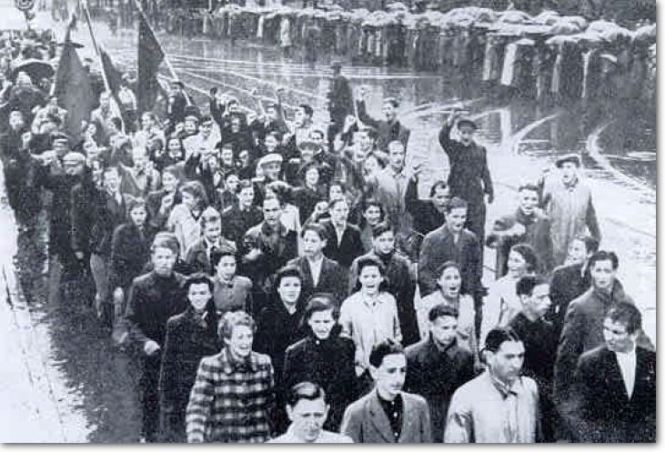
Again, the loudest
screamers and the most ardent participants were Jews, the Chosen People, and the only real voluntary demonstrators.
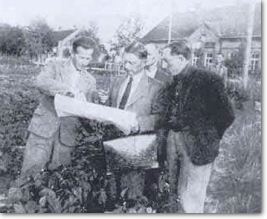
The Land Distribution
Committee at work.
“Farmland, livestock and inventory will be left intact.”
Although new slogans and ever louder promises issued forth, nobody believed them anymore. Not one farmer believed that Latvian
agriculture would be saved from the fate of the collectivised farms in the Soviet Union. The farmers gave up. They sensed
the future. So, the Bolsheviks had to lie to mask their plans as much as possible. The Minister of Agriculture lied gladly.
Latvian farmers’ suspicions proved correct: farms were subdivided to give farm
workers 10 hectares of land each, and minimal livestock to ensure that the new farmers would not thrive. This was the transition
period to kolkhoz (collective) farms. Thus, 10,140 farmers were robbed of their land and livestock.
Quickly and deliberately, according to plans
from Moscow, the poison of Bolshevism was fed into the flesh of the nation. More and more the spirit of the nation’s
life and vitality was threatened. Next to the screaming agitation which paralysed people in demonstrations, the Bolsheviks
used widespread and colourful signs and newspaper articles to feed their ideas into schools and places of higher education,
even the University of Latvia. Youth everywhere, the healthiest and most positive resource of a nation, were subjected to
these pernicious ideas. New “sciences” hitherto unknown on Latvia, were created – a Chair of Marxism-Leninism.
The faculties of theology and philosophy were closed, the staff fired and arrested.
As new replacements were hired, their only qualifications
were diplomas from the ‘Red Professorship Institute’. This institution prepared special instructors
for the dissemination of Bolshevik ideas.. Often these so-called “professors” had problems with written material,
but qualifications were based on the length of membership in the Communist Party and on the number of years spent in prisons.
These men were chosen to be the new educators and leaders of Latvian youth.
Apart from the foregoing innovations, the Latvian Communist Youth
Alliance was created with the task to Bolshevise the Latvian youth. To be successful, it had to mar the spirit of youth
from childhood — by having them join the ‘Pioneer‘ organisation.
The wave of contradictions, lies and exploitation
also swept over factory and office workers. Now they were to work according to impractical plans, goals, and targets, that
could never be achieved. The Stakhanov movement created an artificial fever for raising production quotas, competitions
between factories and firms to improve efficiency. This was a method to falsely mirror the wishes of the workers, compelling
them often to work double time, instead of eight hours. This cruel shock movement drained and totally exploited the energy
of the workers.
Simultaneously, to spiritually destroy the people, the Bolsheviks undermined the support of the nation’s
economic and material life.. Depositors lost their life’s savings in banks and credit unions.. This most of all hurt
the small and thrifty working man. To add to the misery, houses were repossessed, industry and transportation was nationalised,
the farmers’ land was taken for the collectives, and tradesmen’s tools, equipment and apartment furnishings,
were also nationalised.
Ironically, this entire program was called, “a fight for a better future, a fight for the ideals of Marx,
Engels, Lenin and Stalin.”
The tentacles of Bolsehvism had the flesh of the nation firmly in their grip. Only one result
was foreseeable – spiritual helplessness and dullness, physical weakness and overexertion, preconditions firstly for
slavery and then an animal-like existence.
Out on the Streets! Out on the Streets! Out on the Streets!
Demonstrations! Demonstrations! Demonstrations!
Such was the characteristic trademark of the
Bolshevik era: shouted slogans, marches of communist supporters, locals and fifth columnists brought in from Soviet Russia,
the tread of thousands of feet had to proclaim how to commemorate the day when the Dictatorship of the Proletariat was born,
a day that promised paradise on earth.
In reality, these marches, slogan shouting and parades, had to try to drown out the noise of
a life collapsing in ruins from Bolshevik poison and lies. The reality was an indictment of the Soviet occupation that had
transformed life on earth in Latvia into a hell.
Job Seekers at the Labour Exchange in Riga | Ads for job openings
Come wintertime, everybody was surprised by the
new agitation method:

Ads in newspapers invited people
to a Labour Exchange to fill innumerable vacancies and new jobs positions available. When long lines of the unemployed formed
at the Exchange, the staff there knew nothing of these openings.
Elections!
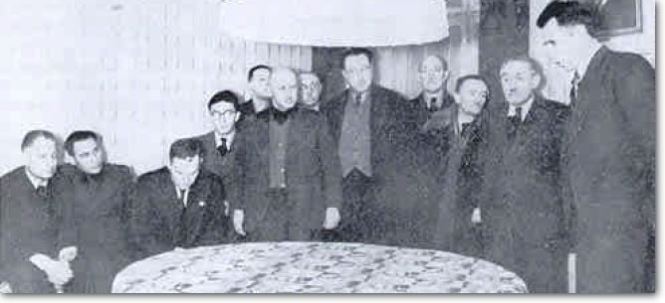
Persuasion at
Home!
January 12,
1941, was a day when Latvians were compelled to do what they did not want to – to vote for the deputies of the U.S.S.R.
Higher Council (the Soviet “parliament” where, of course, there would be only one name, a communist, on the ballot).
In addition to existing methods of driving out the voters, the Bolsheviks invented a new one, so-called “persuasion
at home.“

Bolshevik agents visited individual
flats and apartments, then ordered in all residents to assemble in order to convince and explain to them the significance
of the elections. It is not necessary to note that among the keenest visitors to these meetings were pro-communist Latvian
Jews. When this method was not suitable, it was replaced by meetings in factories and at work, where the only visitors often
were housewives and children.
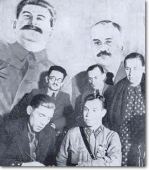
Elections generally, under communism, one of the most underhanded and falsified
methods of gauging the people’s will and conviction, on this occasion were engineered especially carefully. Everyone
had to verify in advance that his name was on the register of the electorate. It was obligatory to vote. If one lacked the
stamp on one’s identity documents, indicating that one had voted, one was liable to the risk of being classified as
a “saboteur”. As always in this terrible time, Jews assumed key leadership roles.

A “Volunteer”
votes.
On January
8th, 1941, the newspaper Cima wrote:
“Who wishes the Latvian nation (!) the fortune
of peaceful life, the joy of labour and new creation, the conviction of safety for self and family, and welfare for the
nation, shall vote for the Bolshevik Party, for the candidate of the communistic and independent bloc.”
But there were no other candidates! It was not possible to abstain. The
inevitable results were clear!
What was not clear, was to what extent this farce would ensure the safety of the Latvian nation and its families.A
few months passed and the mask of hypocrisy began to drop. The malignant, bloodthirsty cynical face of Bolshevism was revealed.
There was no longer any need to hide. All the harm that could be inflicted on the live flesh of the nation had been done.
The nation was disarmed, morally degraded and blindly subjugated. Now could begin the preparations for annihilation. The
will of the nation was again falsified. The workers “demanded death”
for the so-called “murderers”, those police officers, who, while
on duty during the Soviet invasion of June 17, 1940, had attempted to maintain order in the streets against the Bolshevik
mobs.

‘Workers
Resolution’ meeting.
These “workers’ resolutions”
occurred in the following manner. When workers announced that their desire to do certain assignments at the rate of “shock
tempo” or when they “unanimously demanded the highest degree of punishment for the bloodthirsty
[police] hounds”, the procedure was always the same. A representative from the Party or the Union arrived
at the factory with a prepared resolution, read it aloud at a meeting of workers and asked if anyone opposed it. People who
had seen relatives and friends arrested on the slimmest of suspicion, grimly stayed silent. This meant the resolution was
“passed unanimously!”
It is tyrannical to murder, but worse is it
to press a knife in the hand of one nation against its will for the purpose of killing its own countrymen. That was how the
Bolsheviks acted. Their sadism took a form and there is not one more despicable: their method of falsifying a nation’s
will, revealed a degree of callousness that few will want to forgive or forget.
IT WAS CLEAR TO THE NATION WHAT OTHERS ARRESTED
HAD TO EXPECT

“No
grace for murderers of workers: Masses of workers
demand
highest punishment for 17th June executioners.”
We Stand For Peace!
Subjected to Bolshevism by force, the Latvians were coerced to take
upon themselves “the fulfillment of proud duty to the motherland – the Soviet Union.” Latvian youth
were doomed to be recruited into the Red Army.
A sign at the registration
office proclaimed: “We stand for peace, but we are able to respond to the blows of warmongers.“
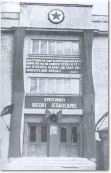
“We Stand
for Peace”
At a colourfully decorated Red Army recruitment office Communist
agents lectured recruits on how dangerous to the Soviet Union was the “capitalist siege”. [below] At
one time, even the Baltic States [with a combined population of fewer than 5-million!] “threatened”
the borders of the USSR. It was no secret that the Soviet Union, while professing peace, was secretly preparing for war.
The Baltic States offered a favourable base for an attack on Germany, and now – in an irony of fate – it came
the turn of the Baltic youth to hand over their lives to the hated Bolshevik occupiers.

Political Instruction
Lecture to Red Army Recruits
Special attention was paid to Latvian youth.
They had to become “True Bolsheviks.” Pioneer – young communist – units were formed.
MOPRA, a Red assistance organisation was legalised. The Komsomol (Young Communist League) was organised, with the goal of
preparing future candidates for the Communist Party.
Tensions existed in
classrooms. If any of the the pupils did not join the Pioneers, the communist educators considered their parents
to be enemies of the socialist state. To be an “Enemy of the State” was to put oneself in grave danger.
With clenched teeth, many parents suppressed their opinions and silently observed their
children joining the bearers of the “New Culture.“
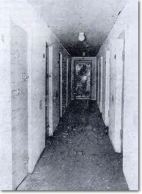
The historical Riga Castle was renamed the Pioneer
Castle. While children in their innocent naivete enjoyed their youthful pleasures, their fathers disappeared from their
homes, from their places of employment, often without a trace. For silent were the corridors of the CHEKA (the NKVD or Soviet
Security Police). There was silence behind the closed doors of the prison cells. Silent were the employees of the CHEKA
and the guards and silent too, were the few who, by a miracle, were able to return from the CHEKA prisons to civilian life.
[Left] A corridor at the CHEKA prison.
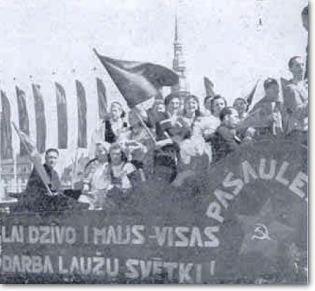
While the Latvian fathers continued to silently disappear, the communists continued
to focus all the skill and ability of their propaganda machine, on unending demonstrations, complete with blaring signs and
chanted slogans. The motley colours, exaggerated sizes of signs and, the artificial, blaring volume and noise on the one
hand, sought to drown out the deep indignation, anger, despair and hatred hidden yet smouldering in the nation’ and,
on the other hand, sought to cover the misdeeds and outrages flowing from the commands and orders of the new conquerors…
In this respect, the May Day celebrations in Riga reached a pinnacle.

1941, May
Day rabble in Riga

People, tired from endless marches,
grew indifferent. Worn out from continual social competitions and long working hours, people grew indifferent to the outside
world. The communists sought to demoralise the spirit of the Latvian nation and strangle it.

BANNERS!
BANNERS! BANNERS!
Placards
Placards Placards!
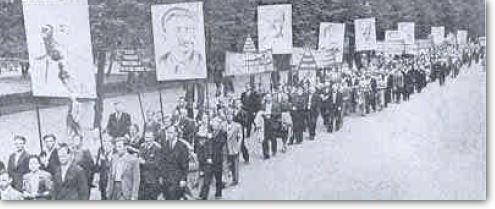
A typical communist
demonstration with signs featuring portraits of the tyrants and slogans.
The
Soviet people were reduced to the level of animals and were forced to see the image of their ruler and judge, Stalin, constantly
before their eyes. This people-control concept was now imposed on Latvia.
The intentions of largely Jewish agitators, shown below left, sought to subject the masses to delusions and falsehoods.
To this end, the propaganda plumbed new depths of wild exaggeration. Demonstrators were led by dancers and commandos to
energize the spectacle.
Neither farmers nor townspeople were spared these endless demonstrations, they were sought
out even in the most remote areas… [more “Home Persuasion”]
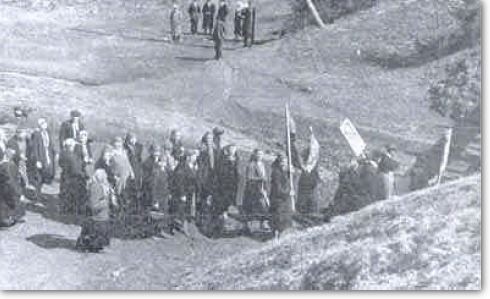

Election Bus [left]
and Decorations on “Freedom” Blvd at Riga [right].
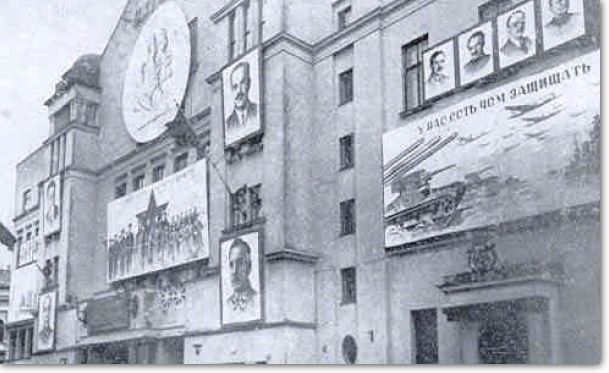
The formerly attractive
front of the Riga Latvian Association (then the Red Army) building, disfigured with signs

Communist operatives and their spies infiltrated every group of people and traveled
to the farthest corners of the land.
Apart from ordinary meetings for the
general public, meetings were called in factories and businesses so that Bolshevik agitators could preach to the workers
the “Just cause of Marx-Engel-Lenin-Stalin.” The workers’ response
is evident from their grim faces…
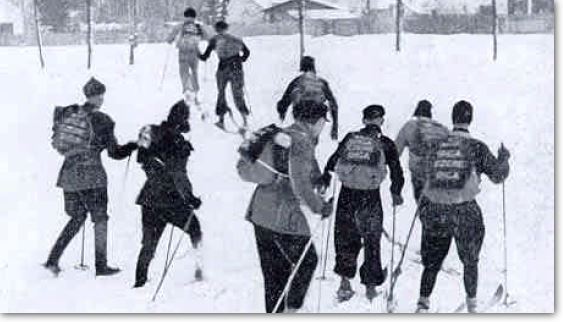
In some places,
special Ski Commandos were organised to enlighten those “still remaining in fascistic darkness”
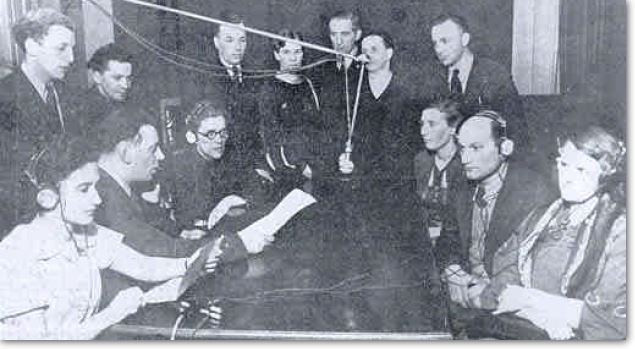
Jews used Radio
contacts with Moscow
These were calculated to impress people with the might of Bolshevik
technology and their “concern and limitless possibilities for improving the welfare of the workers.”
Yet, at the same time, the people were coerced and egged on with inflammatory words to sign agreements to compete and raise
productivity levels. Quantity not quality mattered. Even if the product was useless, the goal must be met!
[left] Workers at one factory sign on for a socialist production contest. [right] The manager,
a Jew, explains to Latvian workers “the great significance” of graphs and plans.
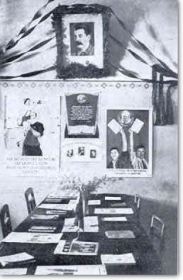
The ‘Red
Corner’ in one company at Riga
The walls of factories and businesses were covered
with graphs and plans, not understood by many. The Latvian worker did his job. A Jewish director monitored him to see that
he filled his quota. When, after work, the stressed and exhausted worker was, according to propaganda instructions, beckoned
to the Red Corner, naturally he didn’t want to attend. This corner of devotion for Stalin and the Party, became
the object of sarcastic remarks and the butt of innumerable jokes.
As well
there were “bulletin board newspapers”, the assembly of which required much time and effort. They were
read only by the Jewish censors… The purpose of the bulletin board was the creation of discord and betrayal, which
are the primary supports for communist and Jewish power. The bulletin board papers openly and sharply criticised “undesirable
occurrences and persons” in the factory, business or institution. There were people who took advantage
of this opportunity to settle old scores or to try to get ahead by denouncing others.
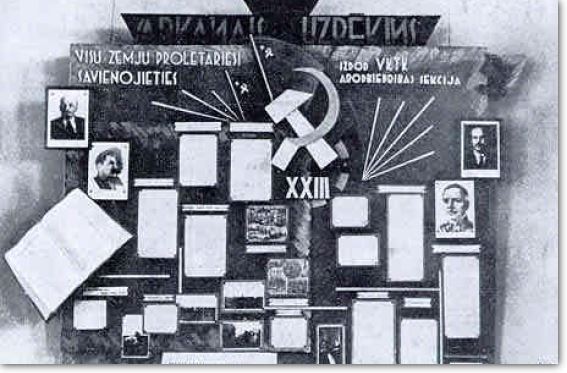
Typical Bulletin
Board newspaper, with Stalin and Lenin as the stars
Starting with the first day of the invasion,
the communists sought to promote the “heights of culture” and said that it would be brought to Latvia,
a “culturally retarded” land. The new Russian cultural forms quickly swamped Latvia.
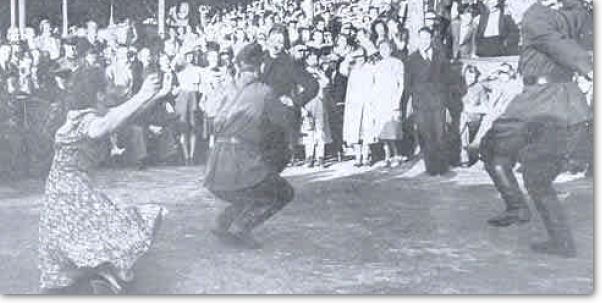
The public performances
of the Red Army in Riga’s gardens.
The serious deportment of soldiers in any
other army would preclude such “cultural” clowning
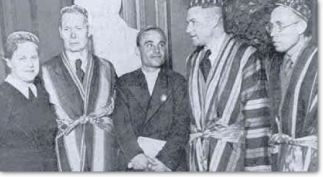
To pledge friendship to Soviet nations, the designated heavyweights of Latvian literature – Andrejs Upitis,
Vilis Lacis, and Janis Niedra – donned Tajikistan morning gowns. This took place when thousands of Latvian sons and
daughters were being deported on trains for slave labour.

The leaders of this new “culture” were mostly Jews, of course; for
example, the Chairman of the School Board Bergmanis and his predecessor Grasmanis…
How deeply Judaism controlled all areas of Latvian life, is demonstrated
by the fact that even managers of sports activities were almost all Jews [below].

Jewish sportsmen
at one meeting during the Bolshevik era.
The report of one patriotic school director asked:
“Where did communism lead our youth? Is it the only hope for the future of Latvian youth?” [handwritten
letter below, with image of Communist star on a Christian church steeple]
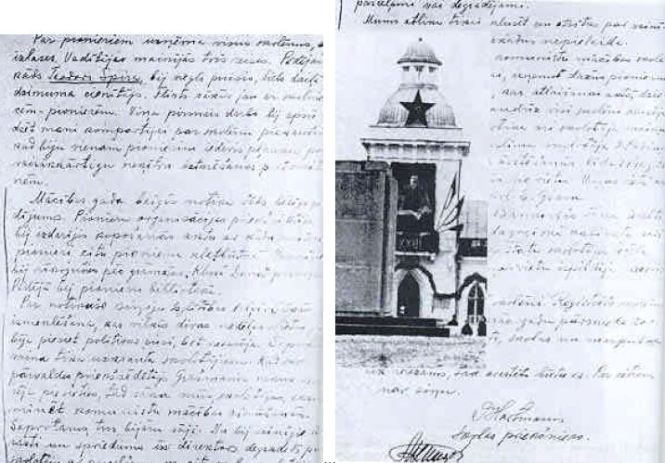
Observe the real sign of communist culture: the Liberation Monument of Latgale (the sculptor K. Jansons)
in Rezenkne at its unveiling and, now in ruins (photo not available) after the arrival of the communists… Crowd
incited by communists, drags a cross they’d broken through Painis Cemetery in Riga.
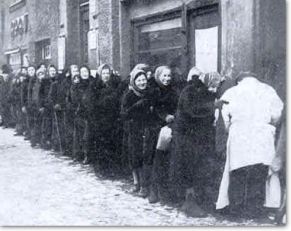
They lined up for their kosher meat. They worship the
cruel Jewish God who demands that animals be slaughtered slowly and tortured according to religious ritual.
“Do not believe in God. Do not believe in yourself. Do not believe in good or evil! Rise
against everything and yourself, for then shall you leave the fortune of equality. For then shall you be easily dominated
and enslaved… Therefore, will you become like animals for your spirit shall be broken.” This was the hidden
intent of the mostly Jewish manipulators.
While Latvians had to endure the communist cynicism forced upon them, while people were set
against one another, while churchgoers were persecuted and gravestones desecrated in the name of communism’s proclaimed
“religious freedom”, the Jews continued to practice undisturbed their religion and traditions, for this
particular “freedom” did not apply to them.

“The most democratic constitution in the world”, Stalin’s
constitution, said it allowed unlimited freedom of religion. However, the communists organised anti-religious displays
and museums. Soon after the arrival of the communists, all the methods tried and tested in the Soviet Union were introduced
in Latvia, albeit unsuccessfully: The churches remained crowded! [left] View of anti-religious display.

At the same time, the judicial conscience of the nation suffered a heavy blow,
when, with the creation of “People’s Courts”, men with no education in the law and often with
no education at all, became judges. Caretakers, servants, cab drivers – of what quality could their judgments be?
How many innocents did they condemn under the pressure of blind power and their own ignorance? [right] One sitting
of a “People’s Court”The whole nightmarish year (1940-1941) was saturated and sealed with absurdities
and ridiculousness. On some occasions, these absurdities surpassed all limits of reason.
The Jews in a demonstration were the first to demand land for farm
workers. Jews never did any farming in Latvia. Jews also, when confiscating farm machinery, were the ones to instruct the
new owners in its use. This was a burning insult hurled into the farmers’ faces. The results of such instructions by
the inexperienced Jews, were as absurd and disastrous as anything in the Bolshevik system. The fields were harrowed before
ploughing! The farm machinery broke and fell useless. [above left] A Jewish Instructor advises a Latvian Farmer.
On July 19, 1940, newspapers reported that “six Hebrew citizens”
wished to organise a piece of land on which to build a collective farm. Unrest among the farmers was calmed by an announcement
in the press by a bigwig named Spure, that collective farms (kolkhozi) were not in the plans – “There shall
be no kolkhozi!”
What a consolation to the suspicious independent
farmer, so that he would not hide seed and would not hesitate to plant his fields. However, the farmers did not believe
the assurances and they were not mistaken in their skepticism.
Forgetting
all their promises, in the spring of 1941, the Soviet power, with no hesitation, assembled the first collective farm. State-run
farms (sovhozi) already existed. No effort was spared to degrade Latvian agriculture down to the level where Soviet agriculture
was after 23 years of existence.
The most
intense attempt to impoverish the land had begun. What remained was the physical destruction of the nation. The oppressive
invaders made careful preparations.
What
the Latvians Thought and Felt
The sequence of events could not be changed. Latvians rejected communism,
closed ranks and united against oppression.
Latvian soldiers ordered by political instructors to march against their
will, did so with military bearing, proudly and with dignity, in controlled disgust. With a nationalistic conscience, they
kept aloof from everything communist.
One unit of Latvian soldiers
marching at the International Youth Day demonstration, display faces that are deeply serious or sharply ironic. They convey
something other than joy under Soviet power. [above right] Most painfully the nation’s misfortune and suffering was
felt by Latvian youth. With grimly determined faces and with obvious reluctance, the youth marched, driven by the fanfares
of May Day, deeply conscious of the nation’s misery.

Pioneers
at a demonstration. Their faces show feelings of being trapped and frightened
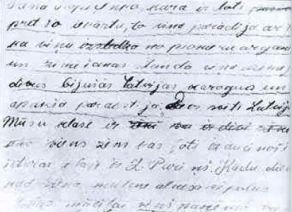
Herded into the strange Pioneer organisation, in a manner repugnant to the child’s
soul, the little Latvians sullenly performed their assigned tasks. Communism was searching in that exact place – among
the youngest – for suitable subjects. The poison of betrayal was injected into the hearts of the smallest.
The betrayal by way of a denunciation
of his classmates contained in a report by one Pioneer [right]
.
[above left] A unit of
Latvian soldiers marching to elections is ordered to pose for press photographers. The officers deliberately turned their
backs to the cameras… Dissatisfaction and the spirit of resistance were manifested everywhere… [above right]
Soldiers in one regiment expressed their resistance to communist absurdities and deliberate depravity in a daring sign:
“We have no place to rest our heads.” This regiment had no permanent billets and was constantly moved
from one place to another.
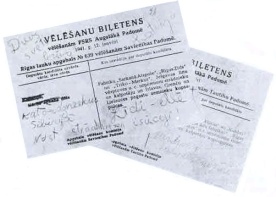
The people found thousands of ways to show their feelings. This was seen in
election ballots covered with remarks or mutilated and in reports of committees being stuck to deal with damage to election
ballots for the June 12, 1941 election. Disregarding the damage, these ballots were later used to round up the percentage
of voters taking part. Everybody knew how difficult it was to express such, albeit, small protests.
The Latvian spirit remained unbroken throughout
all the tribulations – the most horrible known to mankind – starting with the CHEKA and ending with the martyrs
in exile or dead.
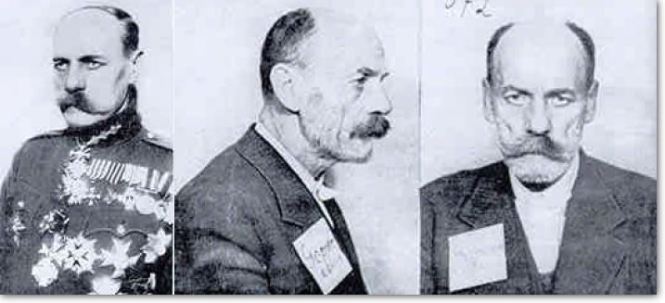
General K. Goppers
in the prime of his life and then beyond the gates of human existence – in CHEKA prison.
THE
LATVIAN SPIRIT MUST BE BROKEN!
This task was pursued most diligently from the very first days by the communist invaders. Those known opponents
not arrested by the CHEKA were often deported.
The order of acting Prime Minister and Minister of the Interior, Vilis
Lacis, to deport the Minister of Defense, General Janis Balodis, was of priority.
SILENT WITNESSES
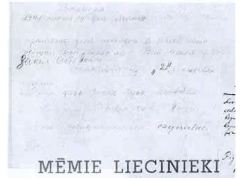
Here is the receipt for “loading” O. Zakis and family, into
a cattle car for deportation. The receipt shows, written as a numeral, that the family consists of “2” people,
but the register shows three. This “order” indicates that the official of the Latvian SSR (Soviet Socialist
Republic) State Security Commissariat Operative Group chief, Comrade E. Saulitis, could hardly read, write or add!
(Order issued to Saulitis).
On the Night of June
14, 1941
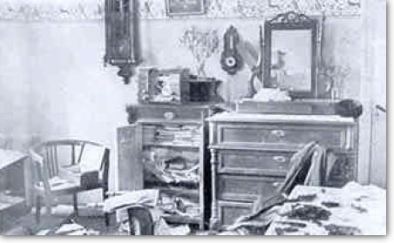
Room from which
a Latvian family was dragged and taken on an untraceable route of torture.
On
this night, Latvians discovered fully the fate assigned to them. On this night, they recognised the real face of communism.
Women, children, the aged – none was spared. On this night, the Soviets arrested the cream of Latvian families, delivered
them to railroad stations and, in cross-barred cattle cars, shipped them to the Soviet Union. Thus, on this night alone,
14,693 of Latvia’s best sons and daughters were torn from the heart of the nation. With these horrible deportations,
Latvians entered the worst stage of their tribulations and sufferings.
In an archive left by the Bolsheviks is a map showing plans for collection
and loading (!) locations for Latvian deportees. The designations are a circle for a collection location and the triangle
for a loading location. Cattle cars were provided for transport.
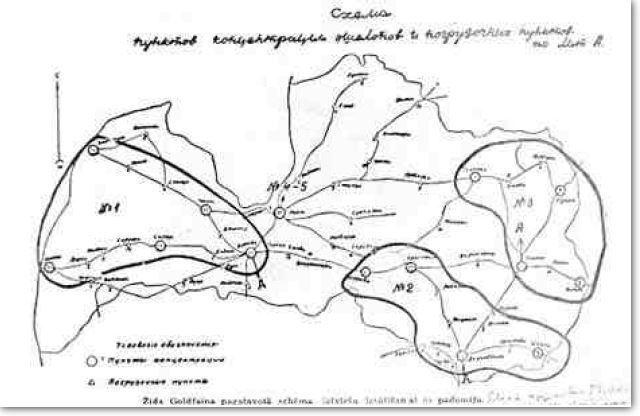
Few photographs were taken to
show the conditions during the deportations of Latvian’s. [below] Railway cars at Ogre Station.
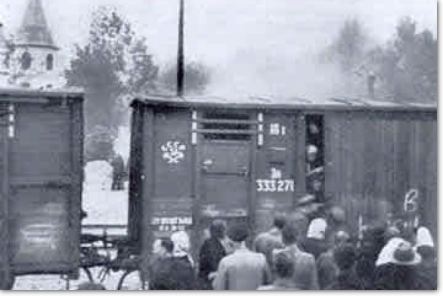
Relatives of the unfortunate deportees, crowd the doors of one of the cars.
CHEKISTS forbade relatives to give the deportees food, drinking water or warm clothing. The unfortunate people arrested had
to endure many days and nights without food and water, over a journey of thousands of kilometers.
[below]
The door is closed!
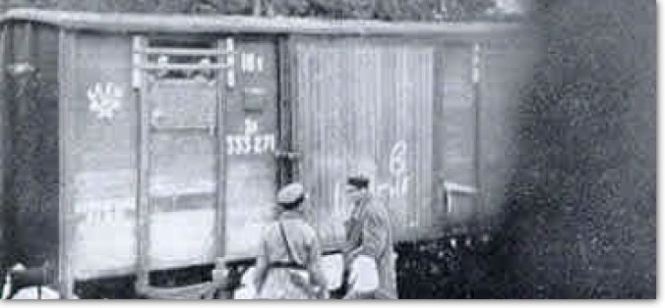
The unfortunate deportees for
the last few moments, gaze at a country many will never see again. The armed CHEKA guards take care of security. How could
women, children and old people put up any resistance? What threat did the communists see in Latvian men, armed only with
a nationalistic spirit and a determination to endure?
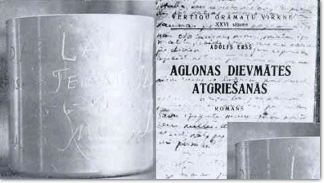
Found by the rail-side, dropped out of a window, is a deportee’s description of their fate, handwritten in a
printed book. Carved into an aluminum drinking cup is a deportee’s last wish:
“MAY LATVIA LIVE FOREVER!“
To the Serbian Tundra

A long line of
rail cars at Rezekne station en route to the Soviet Union

Documents left behind by the
Bolsheviks reveal the destinations of the deported Latvians. The map on the right shows districts of intended locations.
Numbers for each location are specified as numbers of railway cars, not people! A few, who at the last moment discovered
the terrifying communist plans, escaped and went into hiding.

An officer of
the Home Guard with his wife [left]. After three weeks of hiding in the forests, they were scarcely recognisable. [right]
LATVIANS, DO NOT FORGET!

Everyone who went through this
door of the CHEKA, lived through the most terrible fear and the worst torture and suffering. For many Latvians unable to
escape, who did not know how to hide from the Bolsheviks’ bloody clutches, life ended behind these doors.
“The
most democratic constitution in the world”, the constitution of Stalin, “the Father of Nations and of
Working People”, guaranteed that, “Latvia’s future would be happy and sunny.” Thousands
of Latvians endured a bloody and pain-filled night, where death was the only deliverance.
HOW THE CHEKA WORKED
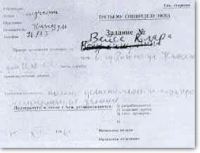
If the CHEKA intended to destroy anyone, it requested that material for that
purpose be found; that is, fabricated. An order addressed to the NKVD Third Special Branch, to provide complete proven and
compromising material on Clara Veiss. Deliberate malice on this occasion is especially conspicuous: Clara Veiss had departed
from Latvia a year before, as shown in an NKVD document.
The Soviets could rely on their mercenaries. Special reports were
ordered for the gathering of incriminating information on people under suspicion. The CHEKA kept a special file on each
one of them. If one institution did not have the needed material, they were borrowed from another.
The report [below
left] of writer Janis Niedra, to the State Security Commissar, Comrade S. Sustin. [below right] Order from Latvian Interior
Commissariat for the gathering of incriminating material.
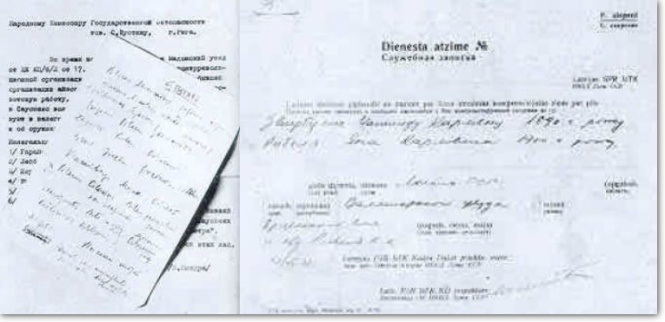
THE LATVIANS WERE PERSECUTED
FROM THE FIRST DAYS OF THE COMMUNIST RULE
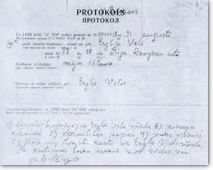
Particulars and directions on persons to be watched, searched or arrested, were
delivered to the CHEKA by a carefully organised network of informers, spies and agents. However, the most valuable service
came from trustworthy men, planted in offices and working places.
The witnesses of the methods of the communist rule. Statements of arrests and searches. A note identifies the searchers.
A few of these,
responsible for the suffering of Latvians. [below left] One is a Jew, Cipe Gutmanis, a thief and a robber, who served 3.5
years in prison for his crimes. He was the Bolshevik officer in the Dwelling Allocation Office. Another was Ernests
Rozkalns, a specialist in break-and-enter and theft. He had 16 convictions. He was the manager of commercial establishments
during the communists’ rule.

The Cheka

Cheka Cells
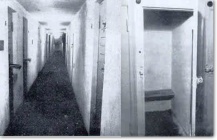
Corridor and Cells in Cheka Prison. Solitary cell used for torture. In this solitary confinement cell,
it is not possible to stretch or lie down. It was used to exhaust prisoners and to reduce endurance and resistance during
interrogations.
One of the CHEKA’s cells. At night time suddenly shouts were heard: “Get up!” CHEKISTS called
out the names of prisoners. They were ordered to follow along endless corridors to a special room. The yard of the CHEKA
prison, where prisoners sometimes were taken for walks.


This
was the Execution Room
Here everything was provided for the killers: wooden padding on the walls to protect the walls
from bullets. The door was covered with soft material to deaden the sound of the gunshots. The floor was concrete to facilitate
the rinsing away of the victims’ blood.
Those unfortunates who entered this room left as corpses.
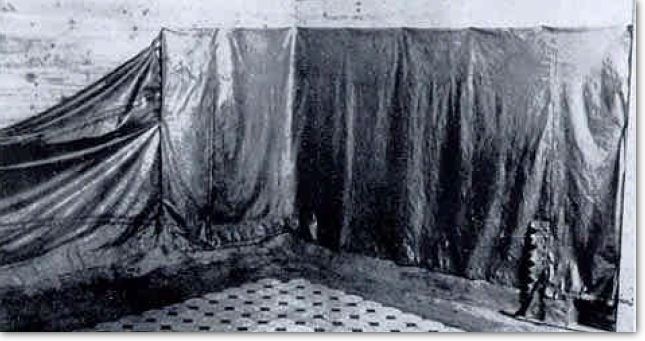
View into the
Execution Chamber
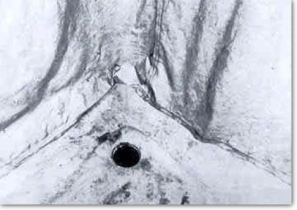
The walls were covered with special coverings to prevent them being splattered
with the blood of the victims. The corner of the cell had a drain for blood. After each execution, the cell was hosed down
in preparation for the next killing. In one groove near the drain, 240 bullets were found. How many had been washed down
the drain?
[right] Drain in the corner of the Execution Cells.
The Killers and Their Victims
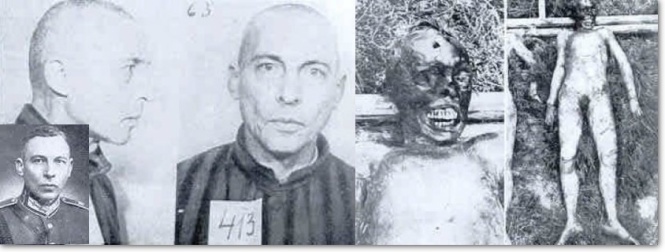
[below]
The Killers: Sustins, Noviks, and Citrons – all three Jews.

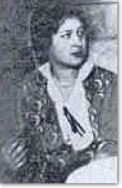
Interior NKVD, later,
State Security Commissar, S. Sustins.
[above center] Interior Commissar, A. Noviks, Sustins’ successor.
[above right] Moses Citrons, CHEKA Director in Daugavpils. His salary was 900
rubles per month – three times the going rate for doctors. Whom did he cure?
Jewess hired by the CHEKA as a torturer.
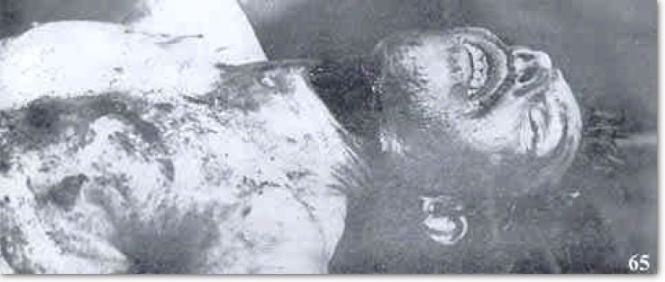
One of the victims
of the communists, murdered with a Jewish “Schechert” or butcher’s cut to the throat
Their Blood Cries From Heaven

Padding removed from the
walls of the CHEKA prison was covered with the blood of the tortured victims. During the night, the corpses of those shot
were taken outside Riga for secret burial. [above right] In the CHEKA prison courtyard, they found blood soaked tarpaulins
used to wrap the victims on their final journey.
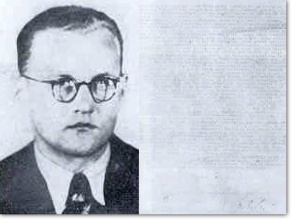
Student, Bruno Rungainis,
one of the few who managed to escape the CHEKA death grip. What tales could the innumerable victims tell who are now silenced
for eternity?
[right The statement of Bruno Rungainis regarding torture at the hands of the CHEKA.

The hideous testimony
of the illiterate Jew Ginsburg regarding nail-pulling torture in Daugavpils Prison.
The Ground Opened Up!

A silent cottage in Baltezers.
There, in locked trucks, armed CHEKISTS transported dozens of Latvian patriots. Beyond the fence of this cottage, their
journey of agony ended! Not far from the cottage among trees full of the sap of life was the freshly dug ground.
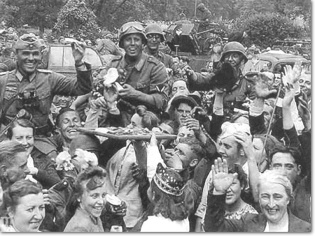
Freed from the bloody yoke, in July, 1941, when the German armies drove out
the Soviet communists, the Latvian ground began to reveal its dreadful secrets… It revealed much of what the communists
had tried to hide behind barred windows, barbed wire fences, in prison basements and in their own secretive brains. Cris-crossed,
thrown into a mass grave in the garden of Baltezers cottage lay some of the prisoners who had been shot. The pit yielded
more corpses, one after another. Latvians welcome the German Army as Liberators and celebrated with refreshments
Video footage [0:38] Wehrmacht enters Riga and Latvians rejoice
and march, flying both Latvian and German flags
together.
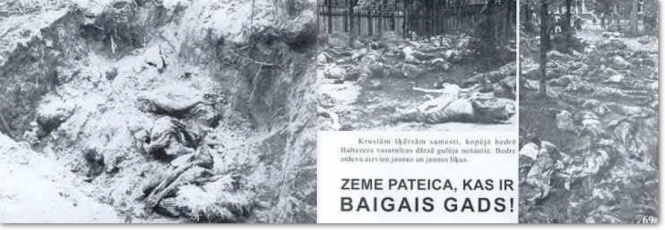
THE EARTH REVEALED LATVIA’S YEAR OF
HORROR!
Victims Found in Baltezers

Great care was needed to bury, with appropriate honours, the martyrs who had
died for their country. Many had been robbed before their deaths, their shoes removed. Many had been stripped of their clothing.
However, even more had had their human appearance removed. Many were scarcely recognisable. They had been disfigured by
blows. Their faces were contorted and transformed by indignities after death.

The hands of
many victims were tied behind their backs. Who could be threatened by these unfortunate, tortured, exhausted people?
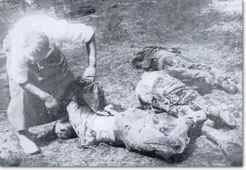
The corpses were undressed
In 23 years, since
their bloody start in 1917, the communists had not changed! The scene of the opened mass grave was similar to those uncovered
in 1919, after the first Bolshevik invasion of Latvia.

The rows of those found
murdered at Baltezers. Murdered Latvians found in Krustpils airport after the communist withdrawal.

At the time when the walls of
basements muffled the screams of martyrs, when shots in the night extinguished many lives, again and again, new grave-sites
gave up their victims. Victims unearthed in Riga at Cross Church. [above right] Rows of the remains
of Latvians shot to death discovered after inspection in Dreiliui.
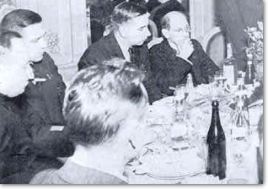
Business as usual while the muffled screams went unheard.
The big wigs saw no evil. From left, members
of the Supreme Council… V. Lacis and Party Secretary, Z. Spure, with the President of the Soviets’ puppet government,
Professor Kirchensteins – take part in the Bolshevik celebrations.In the vicinity of Riga, numerous grave-sites of
shooting victims were found. Each contained 10-30 corpses, sometimes more. Such sites were found in Bikermieki, Preilini
and other places.
How many such graves of those cruelly murdered were and
still are hidden beneath Latvian soil? The names of many of those buried in these graves are not known and the fates of
innumerable people who just disappeared cannot be traced, even today.

Identification
of corpses found at Bikenieki
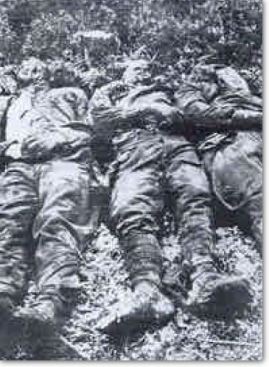
At the start of the war between Germany and the Soviet Union, the Bolshevik terror intensified, reaching the level
of open slaughter. The most horrible fate befell Latvian soldiers. The ones deemed politically “unreliable”
were, dismissed from the service. As they departed from the station, they were lured into a trap and summarily shot.
In the community
of Balvi, on June 29, 1941, three soldiers were murdered: Vilis Lapius, Peter Krauja and an unidentified soldier .
[below left] The rows of dead victims in
Dreilini.

[above right]
Near the Army camp at Litena were found these soldiers shot to death:
From left…
E. Vilkajs, J. Piuka, V. Leja, V. Tumasevics and A. Tumasevics.
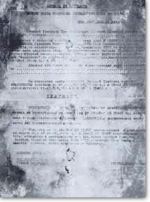
This copy of his death sentence was found on murdered student, Gedimins Frankevics;
“For offences committed by Frankevics, Gedimins, son of Sigismunds, due to their severity, and according to USSR
Penal Code, paragraph 18.58.9 application – the highest degree of punishment. He is sentenced to be shot with the
confiscation of all personal property.” This short text signalled the extinction of the life of a young man and
cut another branch from the Latvian nation’s tree of life.
[below]
The corpse of Gedimins Frankevics. The contusions to his head are mute witnesses to the torture he endured before the deliverance
of death.
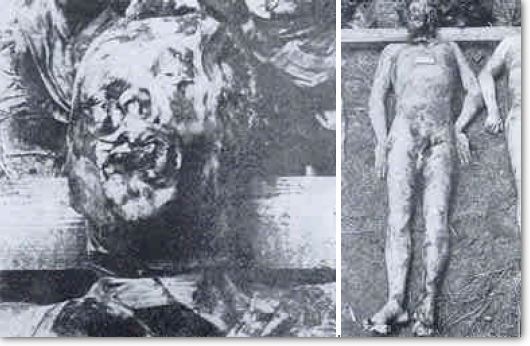
See – There They Are!
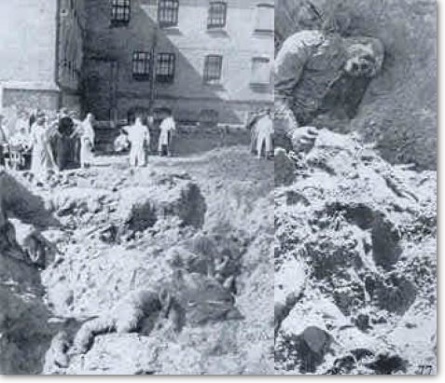
The start of the war drove the bloodthirsty oppressors off Latvian soil. Not
having had enough time to destroy the Latvian nation and sensing the end of their rule approaching, the Bolsheviks brutally
settled accounts with their victims – the prisoners in the Central Prison, helpless, unfortunate, unable to resist.
Only a couple of feet of earth covered the corpses of prisoners shot and carelessly thrown into the pit.
[right]
Unearthing the corpses in the yard of the Central Prison.
IN A COMMON GRAVE
Many of those who had disappeared were relentlessly,
but futilely sought by their relatives, only to be found in these graves, silenced forever.

BUT
THEIR BLOOD SPEAKS
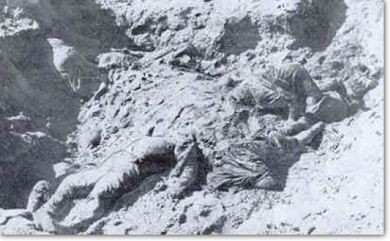
And it can relate more powerfully than any words. The unearthed victims, after
they were disrobed and washed, were identified by close examination.
All that remains of many lives and lifetimes dedicated
to the country.
New victims were found again and again. A row of corpses in the yard of the Central Prison.
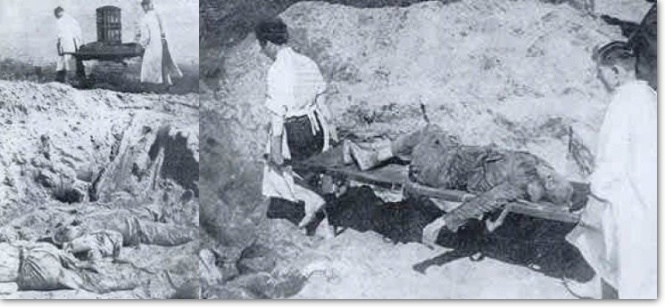
Medical orderlies
remove the victims from the common grave.
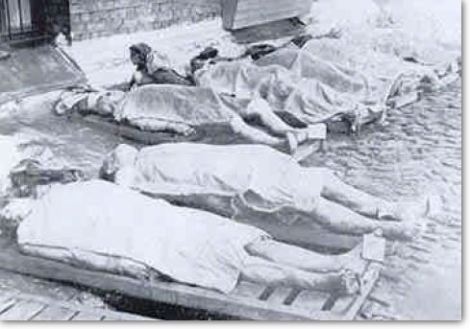
Rows of corpses are lined up in the yard of the Central Prison. This is how
the Jewish Bolsheviks took revenge on imprisoned enemies during the last hours of their rule on July 28, 1941.
The relatives of those shot and lost without a trace are searching for their kin among
the corpses in the yard of the Central Prison .

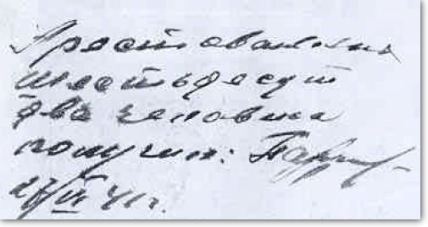
On the right is as document of the Bolsheviks’ sordid cynicism. It is
receipt by an officer of the CHEKA to the prison administration, stating that 62 prisoners condemned to death had been received.
“I received the 62 arrested persons.” Apparently, now the names did not matter, only the number. The
numbers received equaled the numbers shot.

The real scope of the Bolshevik
murderers is evidenced by the Commissar of Internal Security; Sustins’ resolution written in red ink, appropriately
enough, on the register of those arrested: “Bearing in mind the social dangerousness,
all are to be shot!”
This death sentence erased the lives
of 78 people, who, as noted in the register above, were arrested for “counter-revolutionary
activities.” Noted among the counter revolutionary offences meriting punishment by death, were:
-
“Sang
Latvian folk songs.”
-
“On
May 1st, abstained from singing ‘The Internationale.'”
-
“Came from a family of rich farmers.”
-
“Exploited other working people.”
-
“Was hiding in the forest.”
-
“During air raid, he stayed in cemetery.”
-
“Was a member of a student organisation.”
-
“Was a member of Mazpulks (youth organisation).”
-
“Was a policeman.”
-
“Was decorated with Lacplesis Order (a military order).”
-
“While in the Latvian Army, he fought against Bolshevism.”
-
“Was of anti-Bolshevik disposition.”
-
“Ignored Red Army soldiers.”
-
“Criticised Communist Party.”
-
“Was adjutant to President.”
-
“Incited hate against other nations.”
Too Many to be Counted

[above] From left to right:
Tailor Valdemars Janelis – in private life; Tailor Valdemars Janelis – prisoner of the CHEKA (note: gun barrel
to the back of his head); Tailor Valdemars Janelis – victim of the CHEKA.
Whoever knew him alive would not recognise him after death. The CHEKA took care of that!
ALL THAT IS LEFT
OF THEM

WHAT WAS THEIR OFFENCE?
THEIR POSITIONS.
THEIR GREATEST TRANSGRESSION?
SERVING THEIR COUNTRY.
ROW
BY ROW, HUNDREDS AND HUNDREDS EMERGED.
Stanislavs Belkovics



When common mass graves were opened, it was noted that among those executed there
was…
NOT ONE SINGLE JEW!
ONLY A FEW VERY LUCKY ONES WERE ABLE TO SAVE THEMSELVES
FROM THE FATE OF THE REST
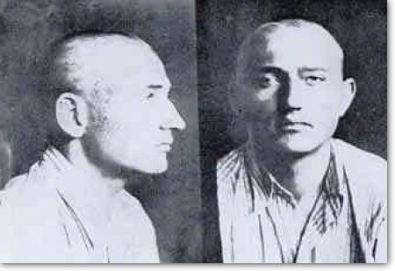
One of those able to avoid the fate of the rest, was Silvestrs Brokans . Brokans
was arrested just prior to the German advance into Riga. The reason given for his arrest, Brokans said: “The Germans
had downed 400 Bolshevik planes and will be here in two weeks.” He received a death sentence on June
26, 1941. A few days passed and Riga was liberated by the German Army. Only a miracle saved him.
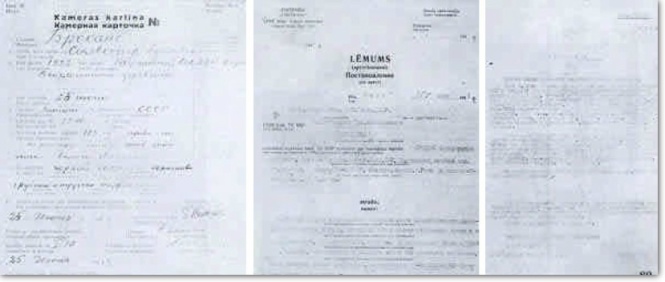
“Passport” of one of those arrested
— his cell I.D. card [left] | The text of the Death Sentence
As
the German forces neared Riga, the Bolshevik terror became indescribable. Street announcements carried messages announcing
arrests.

ANNOUNCEMENT
“Yesterday and today for counter-revolutionary activity – acts of subversion, terror, signalling the enemy,
etc., several persons were arrested. Among them were Lukins Miervaldis, son of Janis; Rainics Nikolajs, son of George; Kagans
Jazeps, son of Abrams; Cuibe Arnolds, son of Janis, and others… All those arrested received the death sentence and
were shot. Anybody discovered supporting the enemy and betraying the motherland will receive like treatment.”
“I appeal to the working people of Riga to be helpful in detection of hostile elements.”
~ The Commander of the Riga Garrison, Lieutenant General Safranov, June 27th,
1941
.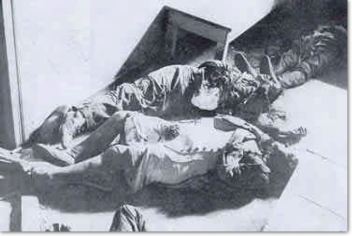
When retreating from Liepaja,
even while in a hurry, the Bolsheviks dealt with their prisoners.
a view of the basement in Piepajas militia headquarters.
The three persons shot to death were all members of one family. Their “offence” was that in front of their apartment,
a white piece of cloth had been found. The motivation for sentencing them to death: the cloth was alleged to be a signal
to German planes.

[above] The pile of corpses
in the basement of the Liepaja Militia. A hand grenade was thrown into the room and anyone still alive was shot dead.

Victims in Daugavpils

Those who suffered
a similar fate elsewhere – The row of persons shot in Valmiera.
THE MURDEROUS LUNACY OF THE BOLSHEVIKS RAGED THROUGHOUT THE COUNTRY
The murdered residents of Jelgava. Before being
shot, they were tortured and afterwards thrown onto a pile a manure.

The murdered workers
of Jelgava
SO ENDED THE ERA OF THE RULE
OF THE BOLSHEVIK SUBHUMANS
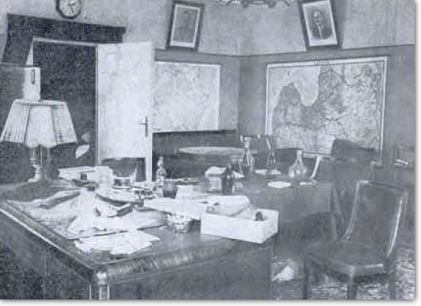
While retreating from Riga before the attacking German Army, the Bolsheviks left
empty bottles in the CHEKA building and a burning city which they themselves had set on fire.

Riga Burns and
the Church steeple in flames

The inner city
of Riga at the departure of the Bolsheviks

They murdered
even when fleeing. A woman murdered by the Jewish Bolsheviks lay in the street on the day Riga was liberated by Germany.
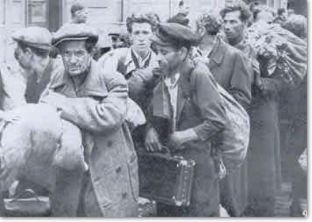
Those who did not feel safe as they were troubled by a guilty conscience, joined
the Bolsheviks fleeing East.
However,
military operations were faster. Many Jewish refugees and Bolshevik supporters were apprehended.
A crowd of refugees after their return to Riga.
SUCH
WAS THE BEGINNING… AND THE END
TALLY
SHEET FOR THE YEAR OF HORROR

All that the Latvians received
from Bolshevik rule, besides promises of
“freedom, brotherhood and equality”
of a happy life and a sunny future, was;
34,250 people
ARRESTED … DEPORTED … KILLED … DISAPPEARED
Documentary: “MY LATVIA” [18:27] as told by Latvian refugee then living in the United States, Albert
Jekste, is a documented account of the brutal occupation of the Bolsheviks during 1940-1941. As a US propaganda film at
the height of the Cold War, it is careful to be politically correct when referring to Germany and making no mention of Jewish
involvement. Nonetheless, it is an accurate representation of the political machinations, revolutionary fifth column elements,
military occupation and the freelance slaughter of the Latvian people.Video [4:24] RT News:
Today, the Latvian patriots who joined forces with Germany to fight against Bolshevism as the Legionaires
in defence of Latvia, are condemned as promoting so-called “Nazism”, the “Far-right”
to the youth of Latvia and inciting “anti-Semitism” and “Xenophobia”, as they march
annually for ‘Legionaires Day’ to commemorate Latvia’s Waffen SS.
Counter-protests always
pursue, with the sad song of “Jewish Persecution” forever echoing in the background… however,
while warnings against the purported dangers of nationalistic ideals are presented, not one of the reporters acknowledge
the bestial slaughter the Latvian people were subjected to, prior to the German Liberation in 1941.
N. Jones is a Writer, Researcher,
Historian and Literary Critic.